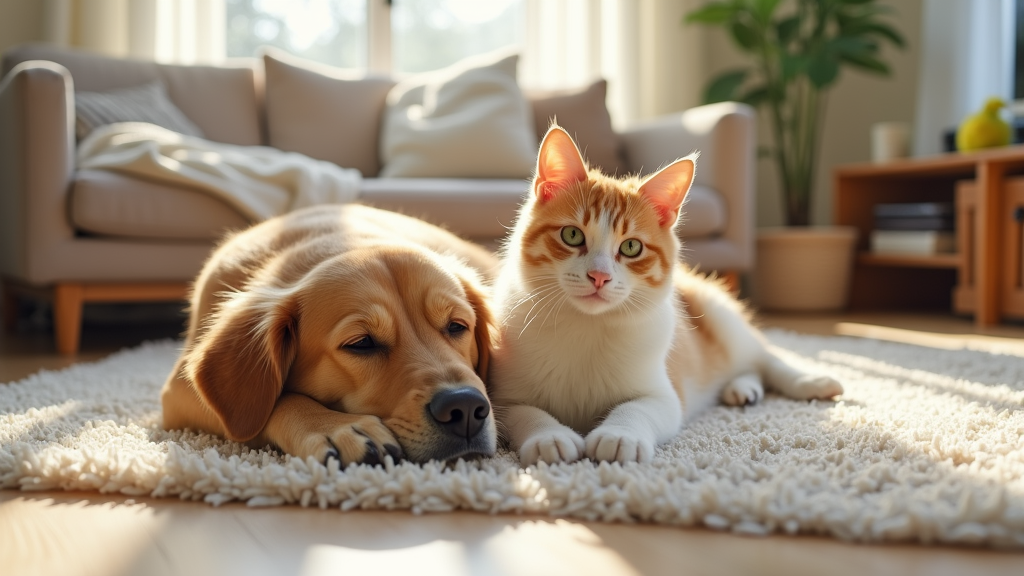Bringing mindfulness practices to hyperactive pets can create a more peaceful home and help your companion animals feel calmer and more settled. I stumbled upon mindfulness exercises after noticing that my own dog struggled with constant restlessness, barking, and having trouble focusing, especially during stressful moments. In this article, I’m going to share practical mindfulness exercises that work well with energetic pets so you can help your furry friend develop a sense of calm and experience a better quality of life together.

Why Try Mindfulness for Hyperactive Pets?
Hyperactivity in pets can show up as excessive barking, running in circles, chewing, or struggling to settle down. It’s common in dogs and cats, especially those with lots of energy, those in unfamiliar environments, or those with nervous personalities. I noticed that when my own dog had no way to burn off energy or relax his mind, he quickly became anxious and harder to redirect. Over time, I learned that bringing mindful and calming routines into his day led to a noticeable change in his behavior.
Mindfulness—focusing on the present moment without judgment—isn’t just for people. Pets, especially dogs and cats, pick up on our emotions and can benefit from gentle routines that help them slow down and notice their world with calm. Many veterinarians now recommend stress-reducing exercises as part of everyday care for anxious or energetic pets. Giving your dog or cat this extra support can make daily routines more harmonious for everyone.
Practicing mindfulness with pets can involve slow breathing, focused attention activities, and creating routines that support calmness. Research from animal behavior experts suggests that structured exercises can lead to improved focus, better sleep, and less destructive behavior. Pet parents report a stronger bond with their furry companions when they include calming work in daily life (American Veterinary Medical Association).
Understanding the Needs of Hyperactive Pets
Before starting mindfulness exercises, it’s really important to examine what drives your pet’s hyperactive behavior. Some pets are naturally more energetic because of their breed or genetic makeup, while others develop excess energy or anxiety due to a lack of mental stimulation, changes in their environment, or boredom. Understanding these factors can be key to choosing the right exercises and routines.
Pay attention to the signs your pet shows to guide which exercises will help the most. For instance, a dog who can’t hold a sit for more than ten seconds likely needs shorter attention-building exercises, while a cat who darts under the sofa at every noise might benefit more from gentle, predictable routines that build trust and safety. Recognizing your pet’s comfort signals and stress triggers helps you tailor your approach for better results.
Checking with a veterinarian or certified animal behaviorist can also help if your pet’s activity seems extreme or you’re not sure why it’s happening. They can rule out medical issues and help you put together a plan that’s right for your pet’s breed and personality. Sometimes, hyperactivity might mask underlying health issues, so getting expert advice is always a smart move if you’re unsure.
Getting Started with Mindfulness Exercises for Pets
Adding mindfulness exercises to your pet’s day doesn’t have to be complicated. I started by picking one or two calming activities and doing them consistently at the same time every day. Short, focused sessions work best, especially for hyperactive pets. Here are some simple terms to get familiar with before trying these exercises:
- Body Scanning: Gently moving your hands over your pet’s body while watching their reaction. This can help you spot areas where they enjoy touch or where they hold tension.
- Controlled Breathing: Using slow, even breaths while sitting with your pet. Pets often relax when they notice your calmer breathing and feel your steady energy.
- Focus Training: Short sessions where your pet is rewarded for looking at you, offering a sit, or simply staying calm, using treats or gentle praise with a soft voice.
Step-by-Step Guide to Mindfulness Exercises for Hyperactive Pets
Mindfulness exercises can be modified to fit your pet’s individual needs. I recommend the following steps as a foundation, especially when introducing calming work with a new pet or one who has a lot of pent-up energy:
- Choose the Right Setting: Pick a quiet space where your pet feels safe and comfortable. Remove noisy toys, and background distractions.
- Start with Gentle Touch: Begin by sitting beside or petting your animal gently. Watch how they respond and stop if they seem stressed.
- Bring in Slow Breathing: Sit or lie down with your pet and take slow, deep breaths. Your calm presence allows pets to pick up on your relaxed state.
- Practice Focus Sessions: Use a treat or favorite toy to get your pet’s attention. Reward calm eye contact or a relaxed posture with praise or a treat.
- End on a Positive Note: Always stop before your pet gets restless. Praise softly or provide a favorite chew or cuddle for a satisfying finish.
Repeating these steps daily helps build routine and trust. Your pet will learn what to expect and how to relax as these exercises become a regular part of their day. Sticking to the same time can help build a natural rhythm.
Common Challenges and How to Work Through Them
Working with hyperactive pets isn’t always easy, and progress doesn’t always happen right away. Here are some hiccups I ran into and practical options for handling them:
- Short Attention Spans: Many energetic pets struggle to focus at first. I found that doing mindfulness work in one- or two-minute sessions spread across the day set a calm tone without pushing too hard.
- Lack of Interest in Touch: Some pets dislike being touched or held. In this case, focus on calm breathing near your pet and reward relaxed body language even from a distance or while using soothing cues.
- Distractions at Home: Other pets, people, or loud noises can interrupt the process. Finding a spot and time with fewer distractions makes a big difference in the success of your sessions.
- Consistency is Hard: Life gets busy, and missing a day or two can happen. Keeping sessions short and linking them to other habits, like after morning walks or before bedtime, means you’ll build consistency more easily.
Short Attention Spans
Young or highenergy pets may lose interest quickly. I keep sessions extremely short—sometimes just a single minute—and always finish with a reward. With time, I’ve noticed my pet stays calm for longer as these exercises become familiar and comforting. Patience pays off.
Lack of Interest in Touch
For pets that avoid touch, staying nearby or encouraging slow movement beside me is sometimes enough on tough days. Over several weeks, my previously jumpy dog began to tolerate, then actually enjoy, short grooming and touch sessions.
External Distractions
No environment is ever totally distractionfree, but closing the door, turning off music, or working in a quiet room helps lessen sudden interruptions that can set a hyper pet back to square one.
Building Consistency
Real change takes routine. Even just two minutes a day can help. Tracking progress or keeping a journal of your pet’s calmest moments can offer encouragement on harder days or help you notice subtle improvements you might otherwise miss. Reward yourself and your pet for sticking with the process.
Even with hiccups, patience and gentle practice pay off. Over time, I’ve seen restless barking and high energy transform into restful moments and better focus, both during training and everyday life.
Leveling Up: Advanced Mindfulness Techniques
When your pet gets used to the basics, you can move on to more advanced calming routines. Here are a couple of things that have worked well for me:
Scent Games: Letting your pet search for hidden treats using their nose channels excess energy into focused work. It gives their mind a job. This is both fun and relaxing after a while.
Why This Works Well: It combines their natural instincts with an activity that requires concentration, gently guiding them toward calmness.
Guided Relaxation Music: Playing low, calming sounds or music made for animals can bring down anxiety. I’ve found that my dog settles quicker with gentle background noise.
Why This Works Well: Quiet music drowns out stressful outside noises, supporting calm behaviors at home.
Interactive Puzzle Toys: Toys that require your pet to figure something out to get a treat engage their mind and lead to natural relaxation after the challenge is over.
Why This Works Well: Mental exercise uses up as much energy as a physical walk, which helps settle hyperactive pets.
All these techniques help shape behavior and encourage a more relaxed mood, even for pets with tons of energy. Trying out new exercises helps you figure out what suits your pet best, adding variety and excitement to their day.
Real-World Benefits and Everyday Examples
Mindfulness exercises really do create improvements for families with hyperactive pets. I’ve seen the changes firsthand: less jumping on guests, easier vet visits, and even better sleep for everyone at home. An anxious cat I fostered began to come out from under the bed more often after a week of predictable calming work and slow breathing together. These small shifts pile up and make a lasting difference.
- Better Focus in Training: Mindful routines help pets learn new commands and behaviors more quickly because they can focus for longer.
- Calmer Everyday Life: With less anxiety, pets are more likely to relax with their families and settle quietly after play or walks.
- Greater Trust: Predictable routines make pets feel more secure and less likely to act out from stress or hyperactivity.
Even small changes matter. Whether I’m working with a bouncy puppy or a highstrung rescue, adding a mindful routine has helped every animal in my care feel safer and more relaxed each day.
Frequently Asked Questions
Here are some common questions people have when they first consider mindfulness exercises for their active pets:
Question: How much time do I need to spend on mindfulness exercises each day?
Answer: Even a minute or two at a time, done a few times daily, can result in progress. Doing it consistently will pay off far more than long sessions that feel stressful for your pet or yourself.
Question: Can mindfulness help with separation anxiety or just hyperactivity?
Answer: While mindfulness is helpful for hyperactivity, it also supports pets with separation anxiety by building trust and predictability through calm, routine exercises. The routines create a sense of safety for your furry friend.
Question: Is it ever too late to start mindfulness with an older pet?
Answer: Age doesn’t matter. Senior pets can benefit just as much from routine and calm attention. In fact, they might welcome new calming routines as they deal with changes in energy or mobility.
Key Takeaways for Busy Pet Parents
Introducing mindfulness to a hyperactive pet brings huge benefits for both animals and their people. I’ve seen major improvements in focus, rest, and overall happiness after adding short, predictable calming routines to daily life. Keep sessions brief and consistent, reward relaxed behaviors, and don’t give up if change feels slow—these are the biggest tips from my personal experience with energetic pets. Step by step, and with a bit of patience, your pet can learn to relax, leading to a more peaceful home for everyone. Enjoy this new adventure together!
